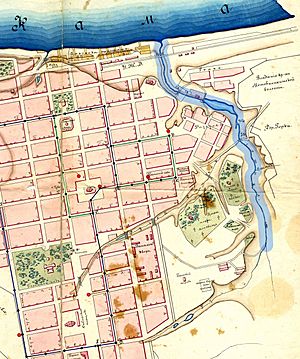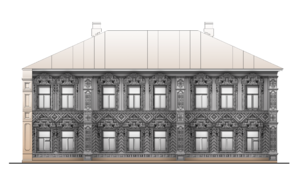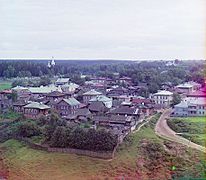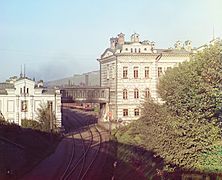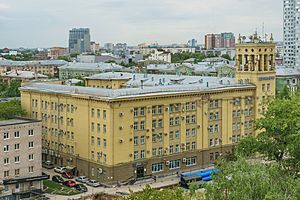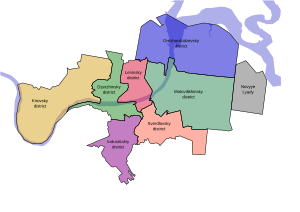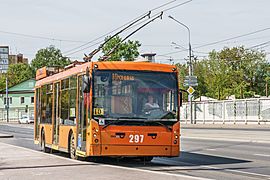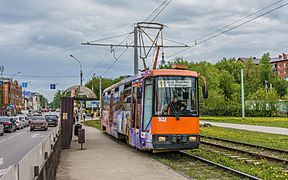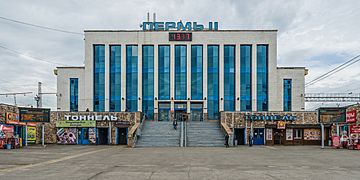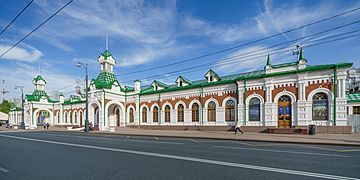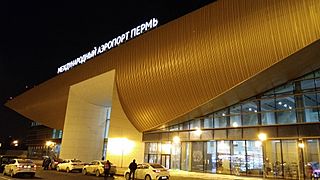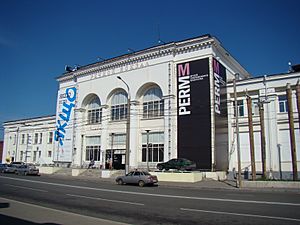Perm facts for kids
Quick facts for kids Perm (English)Пермь (Russian) Перем (Komi-Permyak) |
|
|---|---|
| - City - | |
 View of Perm |
|
|
|
|
| City Day | June 12 |
| Administrative status | |
| Country | Russia |
| Federal subject | Perm Krai |
| Administratively subordinated to | city of krai significance of Perm |
| Municipal status | |
| Urban okrug | Perm Urban Okrug |
| Mayor | Alexey Dyomkin |
| Representative body | City Duma |
| Statistics | |
| Area | 799.68 km2 (308.76 sq mi) |
| Population (2010 Census, preliminary) |
991,162 inhabitants |
| - Rank in 2010 | 13th |
| Density | 1,239/km2 (3,209/sq mi) |
| Time zone | YEKT (UTC+06:00) |
| Founded | May 15, 1723 |
| City status since | October 29, 1781 |
| Postal code(s) | 614xxx |
| Dialing code(s) | +7 342 |
| Official website: http://www.gorodperm.ru/ | |
Perm (Russian: Пермь), also known as Yagoshikha (1723–1781) and Molotov (1940–1957), is a large city in Russia. It is the main city of Perm Krai. Perm is located on the Kama River, close to the Ural Mountains.
The city covers an area of about 800 square kilometers. Over one million people live in Perm. It is the fifteenth-largest city in Russia. Perm is also the fifth-largest city in the Volga Federal District.
In 1723, a factory for smelting copper was built in the village of Yagoshikha. This village later became the city of Perm in 1781. Perm's location on the Kama River was very important. The river connects to the Volga River, which helped Perm become a major trade and manufacturing center. It was also on the Siberian Route and the Trans-Siberian Railway.
Perm grew a lot during the Soviet period as industries developed in the Urals. From 1940 to 1957, the city was called Molotov. After that, it returned to its original name, Perm. Today, Perm is still a big railway center and a key industrial city in the Urals region.
Contents
What's in a Name?
The name Perm comes from Uralic languages. In the Komi-Permyak language, it is Perem. In Finnish, perämaa means "far-away land." In Hungarian, perem means "edge." The Permian period in geology is also named after this region.
Perm's Location and Rivers
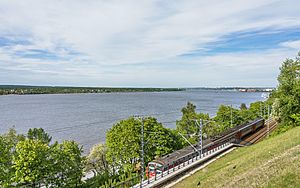
Perm is built on hills along the Kama River. The Kama River is the main branch of the Volga River. It is one of Russia's deepest and most beautiful rivers. This river allows the Ural Mountains region to reach many seas. These include the White Sea, Baltic Sea, Sea of Azov, Black Sea, and Caspian Sea.
The Kama River divides Perm into two parts. The city stretches for about 70 kilometers along the Kama. It also spreads about 40 kilometers across the river. The city's streets mostly run parallel to the Kama River. Other main streets cross them. This street plan works well with the city's hilly areas.
Perm also has many smaller rivers and streams. The biggest ones are the Mulyanka, the Yegoshikha, and the Motovilikha. These are all on the left side of the Kama River. The Gayva is on the right side.
Perm has a continental climate. This means it has warm summers and long, cold winters.
A Look at Perm's Past
Perm is located in an old area of the Permiak people. The village of Yagoshikha was first mentioned in 1647. The modern city of Perm began when Tsar Peter the Great started developing the Ural region. Vasily Tatishchev, who was in charge of Ural factories, founded Perm. He also founded Yekaterinburg.
In the 1800s, Perm became a major center for trade and industry. By the 1860s, it had over 20,000 people. There were factories making metal, paper, and steamboats. In 1870, an opera theater opened. In 1871, Russia's first phosphoric factory was built here. In 1916, Perm State University opened. It is now a major school in Russia.
During the Russian Civil War, Perm was an important target. This was because of its military munitions factories. On December 25, 1918, the White Army took Perm. On July 1, 1919, the Red Army took the city back.
- Some early color photographs by Sergey Prokudin-Gorsky, taken in 1910
Perm in the Soviet Era
In the 1930s, Perm became a big industrial city. Factories for aviation, shipbuilding, and chemicals were built. During World War II, Perm was a key center for making artillery for the Soviet Union. During the Cold War, Perm became a closed city. This meant visitors needed special permission to enter.
Perm Today
Today, Perm is an important center for government, industry, science, and culture. Its main industries include machinery, defense, and oil production. About 3% of Russia's oil comes from here. Other industries are oil refining, chemicals, timber processing, and food production.
How Perm is Organized
Perm is the main city of the Perm Krai region. It is also the administrative center for Permsky District. However, it is not part of that district itself. Perm is considered a "city of krai significance." This means it has the same status as a district. As a local government area, it is called the Perm Urban Okrug.
City Districts
Perm is divided into seven city districts for administrative purposes:
| City District | Population (2010 Census) |
|---|---|
| Dzerzhinsky | 155,632 |
| Industrialny | 157,575 |
| Kirovsky | 127,793 |
| Leninsky | 48,520 |
| Motovilikhinsky | 179,961 |
| Ordzhonikidzevsky | 111,204 |
| Sverdlovsky | 210,477 |
Perm's Economy and Industries
Perm has the largest industrial output among cities in the Urals. It produces more than Yekaterinburg and Chelyabinsk. About 35% of all industry in Perm Oblast is in Perm. The biggest industries are power engineering, oil and gas refining, and machine building. Chemicals, forestry, printing, and food industries are also important.
Many big industrial companies are in Perm. These include Perm Motors and Aviadvigatel, which make aircraft engines. Proton-PM makes rocket engines. Other companies produce electrical equipment and cables. Oil and natural gas companies like LUKoil-Perm Ltd. are also here.
Getting Around Perm
Perm is an important railway hub on the Trans-Siberian Railway. Train lines connect it to Central Russia, the northern Urals, and the far east of Russia. Perm has two main railway stations: Perm I and Perm II.
The Kama River is a vital link. It connects the European part of Russia to sea ports. These ports are on the White Sea, Baltic Sea, Sea of Azov, Black Sea, and Caspian Sea.
Perm is served by Bolshoye Savino international airport. It is located about 16 kilometers southwest of the city.
The city's public transport includes trams, buses, and city-railway lines. The trolleybus service stopped in July 2019.
Future Metro Plans
There have been plans to build a metro system in Perm. The first ideas came up in the 1970s. A study was done in 1990, but money problems stopped the project. Plans were looked at again in the early 2000s. However, a lack of funding has kept the project on hold. Light rail has also been considered.
Culture and Arts in Perm
The Perm Opera and Ballet House is one of the best in Russia. Perm has many other theaters too. These include the Drama Theater, the Puppet Theatre, and the Theatre for Young Spectators.
Perm has several museums and art galleries. The Perm State Art Gallery has amazing art collections. It includes paintings from the 15th to 18th centuries. It also has wooden sculptures from the region. The gallery is in an old orthodox cathedral building. Its spire rises high over the city.
The Perm Museum of Contemporary Art (PERMM) opened in March 2009. It focuses on modern art.
The RAV Vast steel tongue drum was invented in Perm. It was created by Andrey Remyannikov. This instrument is special because its notes have many harmonic overtones. These overtones resonate with other notes, creating a long, echoing sound.
The Legend of Perm Bear is a sculpture in the city center. It shows a walking bear, which is also on Perm's coat of arms. It is located on Lenin Street. The sculptor is Vladimir Pavlenko.
Learning and Education
Perm is an important scientific center. Some science institutes are part of the Perm Scientific Center. This center is part of the Russian Academy of Sciences.
Perm is home to several major universities. These include Perm State University and Perm State Technical University. There are also universities for teaching, medicine, and agriculture. The city also has three military schools.
Perm's Climate
Perm has a humid continental climate. This means it has warm summers and long, cold winters. Winters are usually snowy and quite cold. Summers are moderately warm, but nights can be cool. Because Perm is far inland, the weather cools down quickly as days get shorter.
People of Perm
At the time of the 2010 Census, the main ethnic groups in Perm were:
| Ethnicity | Population | Percentage |
|---|---|---|
| Russians | 823,333 | 90.7% |
| Tatars | 34,253 | 3.8% |
| Bashkirs | 7,729 | 0.8% |
| Komi-Permyaks | 7,301 | 0.8% |
| Ukrainians | 6,507 | 0.7% |
| Udmurts | 4,847 | 0.5% |
| Others | 23,985 | 2.7% |
Sports in Perm
Perm hosted the 2002 European Amateur Boxing Championships.
Here are some sports clubs in Perm:
| Club | Sport | Founded | Current League | League Rank |
Stadium |
|---|---|---|---|---|---|
| Zvezda 2005 Perm | Football | 1994 | Women's Supreme League | 1st | Zvezda Stadium |
| Oktan Perm | Football | 1958 | Russian Second Division | 3rd | Neftyanik Stadium |
| Molot-Prikamye Perm | Ice Hockey | 1948 | Higher Hockey League | 2nd | Universal Sports Palace Molot |
| Prikamye Perm | Volleyball | 1983 | Volleyball Super League | 1st | Sukharev Sports Complex |
| Permskie Medvedi | Handball | 1999 | Handball Super League | 1st | Permskie Medvedi Sports Complex |
| Parma Basket | Basketball | 2012 | VTB United League | 1st | Universal Sports Palace Molot |
From 1995 to 2008, the Ural Great basketball team was in Perm. It was the only Russian basketball champion other than CSKA. There is also an amateur bandy team called Kama.
Famous People from Perm
Many notable people were born in Perm or became famous while living there.

- Sergei Diaghilev (1872–1929), a famous ballet producer.
- Alexei Ivanov (born 1969), an award-winning Russian writer.
- Natasha Poly (born 1985), a supermodel.
- Alexander Stepanovich Popov (1859–1905), a physicist. He is seen locally as the inventor of radio.
- Dmitry Rybolovlev (born 1966), a Russian billionaire businessman.
- Katerina Shpitsa (born 1985), an actress.
- Nikolay Slavyanov (1854–1897), who invented an early way of arc welding.
- Peter Struve (1870–1944), an economist and philosopher.
- Andrey Voronikhin (1759–1814), an architect and painter.
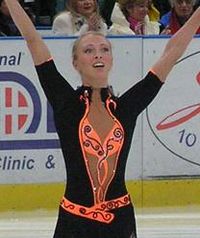
Sports Stars
- Vladimir Chagin (born 1970), a Russian rally raid driver.
- Alexandra Kosteniuk (born 1984), the 2008 Women's World Chess Champion.
- Tatiana Totmianina (born 1981), a pair skater and 2006 Olympic Champion.
- Maxim Trankov (born 1983), a pairs figure skater.
- Konstantin Zyryanov (born 1977), a footballer who played for the Russian national team.
The Nobel-prize-winning writer Boris Pasternak (1890–1960) lived in Perm for a while. He used the city in his novel Doctor Zhivago. In the book, it is called "Yuriatin."
City Marketing
Perm is an example of city marketing in Russia. The city even has its own logo.
Sister Cities
Perm is twinned with these cities:
 Agrigento, Sicily, Italy (2012)
Agrigento, Sicily, Italy (2012) Amnéville, Moselle, France (1992)
Amnéville, Moselle, France (1992) Duisburg, North Rhine-Westphalia, Germany (2007)
Duisburg, North Rhine-Westphalia, Germany (2007) Louisville, Kentucky, United States (1994)
Louisville, Kentucky, United States (1994) Oxford, Oxfordshire, United Kingdom (1995-2022)
Oxford, Oxfordshire, United Kingdom (1995-2022) Qingdao, Shandong, China (2006)
Qingdao, Shandong, China (2006)
See also
 In Spanish: Perm (desambiguación) para niños
In Spanish: Perm (desambiguación) para niños
- Immaculate Conception Church, Perm
- Stephen of Perm
Images for kids
-
The Kama River near Perm



